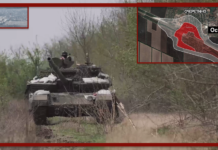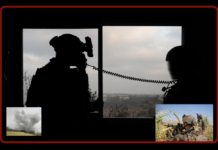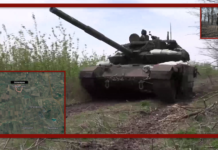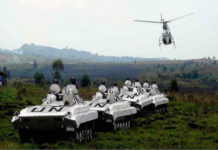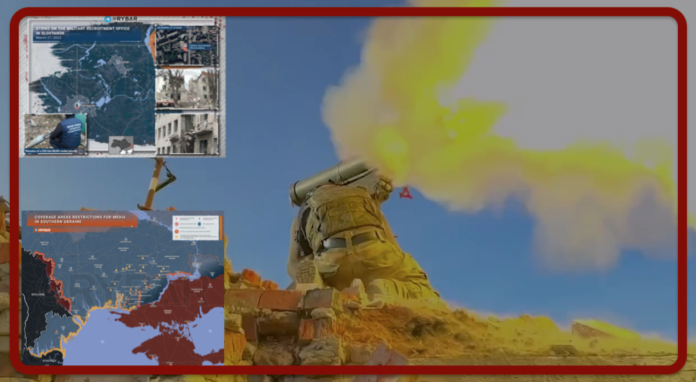
On 25 March, the President of Ukraine Volodymyr Zelensky stated that Kiev cannot launch a counter-offensive yet. He explained this by the fact that the country is waiting for the supply of US tanks, artillery, and multiple-launch rocket systems. In the meantime, Ukraine was awarded yet another loan from the International Monetary Fund that allowed Kiev not to repay its debts until 2027. The amount of the loan is $15.6 billion.
Putin on depleted uranium also said on 25 March: ‘Russia has something to answer for, we have hundreds of thousands of such bullets’.
Kiev is calling for an immediate extraordinary meeting of the UN Security Council because of Russia’s decision to deploy tactical nuclear weapons in Belarus, the Ukrainian Foreign Ministry said in a statement. In its statement, the agency calls on the G7 and the EU to warn Minsk of the ‘far-reaching consequences’ of Russia’s nuclear weapons deployment. Kiev also expects ‘effective action’ from the permanent members of the UN Security Council – the US, China, Britain and France, who have ‘a special responsibility to prevent threats of aggression using nuclear weapons’, the report states.
On 26 March in the pages of the Sunday Times it was reported that the Ukrainian armed forces are losing 100 to 200 men a day during the battles for Bachmut. According to the publication, the heavy losses suffered by the Ukrainian side may force Kiev to leave Bachmut. According to Western analysts, the Ukrainian armed forces will have to choose between holding the city at all costs and retreating to Slavyansk and Kramatorsk, where fortified positions have already been set up to deter a further Russian advance.
On 27 March also Ukrainian President Volodymyr Zelenskyy said he had visited advanced positions of Ukrainian troops in the Kiev-controlled part of the Zaporozhye region. “Zaporozhye region. Advanced positions. I have the honour to be here,” Zelensky wrote on his Telegram channel, accompanying the posting with a video featuring the Ukrainian army. Earlier, the Ukrainian president’s office stated that Zelensky visited positions occupied by units of the country’s armed forces in the Bachmut direction on 22 March, and visited the Kiev-controlled part of the Kherson region on 23 March.
On 26 March, Kiev attempted to carry out an attack with an unmanned aerial vehicle of the Strizh type in a shock performance, the Russian Defence Ministry said. At least eight private houses and a high-rise building were damaged following an explosion in Kireevsk, Tula region. Three people died. The number of fatalities was not important because according to the Ministry of Defence, the Pole-21 electronic warfare system went into operation and hit a Ukrainian attack UAV, its navigation system was disabled, the drone then crashed in the Kireevsk area.
The commander of the Ukrainian ground forces, Alexander Syrsky, also visited military positions near Bachmut on 27 March to assess the situation and made a number of operational decisions, Military Media Center writes. Earlier, Syrsky stated that Kiev may soon go on the offensive in the Bachmut region. “Commander of the ground forces of the Ukrainian Armed Forces Alexander Syrsky once again visited the hottest spots in the direction of Bachmut. He assessed the situation and took a number of measures to resolve problems preventing the effective implementation of combat missions. The commander also made a number of operational decisions aimed at strengthening our containment capabilities and inflicting defeat,’ writes the Military Media Centre. According to Syrsky, ‘Bachmut’s defence is due to military necessity’.
And if the Ukrainians still think they will defeat the Russians at Bachmut, the founder of the Wagner group, Yevgeny Prigozhin, said that the Russian Defence Ministry has taken over security on the flanks, so Wagner now has all the cover it needs to advance. Earlier, in an open letter to Russian Defence Minister Sergei Shoigu, Prigozhin had stated that, according to information in his possession, a large-scale offensive was planned by Kiev between the end of March and the beginning of April to cut off the Wagner group and called for taking ‘necessary measures to prevent the disruption’ of the groups from the main forces of the Russian Armed Forces.
Responding to the Ukrainian military commander’s words was the Wall Street Journal’s view that Kiev, despite military training and the influx of Western equipment, will not be able to launch a NATO-style offensive involving a massive air strike. “Despite the training and influx of NATO equipment, Ukraine will not be able to launch a NATO-style attack. Air attack with aircraft and cruise missiles,’ the publication wrote. According to John Nagle, a former US lieutenant colonel, Ukrainian troops only have a limited number of fighter planes and attack helicopters, so Kiev is unlikely to risk them in a frontal attack.
On 27 March, an attempt was made on the life of police chief Moskvin in Mariupol. The man escaped the attack.
Also according to social media sources, the Russian military is advancing in the forests near Kreminna (LPR): in two days they have advanced 500 metres along the entire front line. In addition, Russian paratroopers and specnaz have taken six strongholds of the Ukrainian armed forces, two of which were heavily fortified, fighters told RT’s military correspondent Stanislav Obishchenko. The main job of the Russian forces is now to level the front line. They then plan to strike the enemy on the Seversky Donetsk River.
Ukrainian sources report that the Russian armed forces again struck targets identified in the Sumy region in the morning. They do not say what they are working on, but not so long ago, planing bombs began to be used in the Sumy region, which also according to enemy statements led to increased losses of the Ukrainian armed forces.
The Russians also, it is learnt via social media, are using Lancet-3 in the direction of Zaporozhizhia. In the first half of the day on 27 March, the Russian armed forces attacked in Orekhovo and adjacent areas. Ukrainian positions in the city and positions of the Ukrainian Armed Forces on the outskirts and in the Novodanilovka area are affected by Russian strikes.
In the Avdiivska Directorate come reports from the southern flank of the Russian offensive. One post reads: ‘OSN “Viking” works. The Grad MLRS is dismantling positions of the Ukrainian Armed Forces in Tonenkoe, ATGM crews are hitting the remains of Ukrainian militants in Experimental. A Fury, an enemy reconnaissance UAV, is flying over our film crew. It is difficult to destroy with such small arms fire: you have to hit the engine or the ‘brain’. But with us, the fighters pierced its wings considerably, which is why it started to contract and descend considerably – most likely, it did not reach the landing site’.
From that direction, according to the Russians, the bombardment of Donetsk has been coming for almost nine years.
In terms of air strikes and mutual bombardment in the zone of operations on the night of 26-27 March 2023, the situation was as follows: the Russian Armed Forces attacked the positions of the Armed Forces of Ukraine in Novovasilievka, Volfino and Bachevsk in the Sumy region. In the Kharkiv region, the Russian military hit targets in Strelechya, Staritsa and Melovo. In the Starolbisk direction, the Russian military struck the concentration sites of Ukrainian formations in Kupyansk, Stelmakhivka and Makeevka.
In the direction of Bachmut, Russian forces struck Ukrainian military positions in Bachmut, Chasovoy Yar and Seversk. Russian forces carried out missile attacks on Ukrainian military equipment and manpower concentration sites in Kramatorsk.
In the direction of Donetsk, Russian troops hit enemy manpower accumulation in Avdiivka, Kamenka and the western suburbs of Maryinka. Ukrainian formations again fired at the territory of the Stirol company in Gorlovka: the nitric acid shop and the office building were damaged.
In the direction of Yuzhnodonetsk, the Russian military attacked targets in Novomikhailovka, Vugledar and Prechistovka. The RF military struck positions of the Ukrainian armed forces in Olhovsky, Charivny and Orekhov, in the Zaporizhizhia region. In turn, the Ukrainian formations fired at the college in Melitopol: according to preliminary data, several buildings were damaged, four people were injured.
In the southern sector of the front, Russian units attacked the enemy force in Novoselka, Olgovka and Kherson. At night, the Ukrainian armed forces fired on residential buildings in Novaya Kakhovka, Tavriysk and Vasilyevka.
Also via social media, it is reported that Ukraine issued a new statement on restrictions on the work of the media in southern Ukraine. On 25 March, the Operational Command ‘South’ of the Ukrainian Armed Forces announced the introduction of restrictions on the activities of media workers in the command’s area of responsibility in the Odessa, Mykolaiv, Kherson and Dnepropetrovsk regions.
In accordance with the new requirements, journalists and reporters have been assigned three zones: ‘red’, where media presence is strictly prohibited, ‘yellow’ – media workers may work in the presence of a specially authorised official, and ‘green’ – there are no restrictions.
Red Zone
It is strictly forbidden to visit military bases, training camps, ports and airports, as well as other critical infrastructure. In addition, journalists are not allowed to work in areas bordering Pridnestrovie. In the regions of Mykolaiv and Kherson, journalists from Pravdino, Posad-Pokrovsky, Kiselevka, Novopetrovka, Lyubomovka, Snigirevka, Davydov Broda, Belaya Krinitsa and Vysokopolie are not allowed to be. In these settlements, among other things, events are held to prepare the mobilised.
Media workers are also forbidden to approach the banks of the Dnepr-Bug estuary, the Ingulets river and the Kakhovka reservoir, where DRGs have launched boat and assault teams attacks against Russian positions.
“Yellow Zone”
Accompanied by authorised representatives of the Ministry of Defence of Ukraine, journalists and cameramen can work in several settlements in the Mykolaiv and Dnepropetrovsk regions. Some of them also have training camps for mobilised persons. With restrictions, one can shoot along the Black Sea coast. The territory of the Alibey Reserve, south of Odessa on the Black Sea coast, is partially included in the red zone. Close to the nature protection zone is the Tuzly test site, where the OTRK Grom-2 is being tested. Tuzla now has four OTRK launchers. In addition, the activities of journalists near the Transnistrian border are completely forbidden. This is due to the concentration of several hundred people and a dozen weapons in the PMR, which is constantly denied in Kiev. Dozens of foreign mercenaries also operate in the border villages.
And the establishment of the ‘red zone’ along the Kakhovka reservoir, the Dnieper and the Dnieper-Bug estuary is more associated with preparations for a counter-offensive by the Ukrainian armed forces and the probable forcing of a water barrier to divert the attention of Russian troops from the main strike.
At the end of the article we learn that the Russian armed forces bombed the military registration and enlistment office in Slavyansk. Two people died and 32 were injured. According to the pro-Russian social sphere against the background of Ukrainian preparations for a counter-attack near Bachmut, Russian armed forces are attacking facilities in the Slavyansko-Kramatorsk agglomeration on an almost daily basis. Some of the attacks are quite effective: in particular, on 25 March, they succeeded in striking Ukrainian troops on the territory of the Emal plant in the village of Yasnaya Polyana.
Graziella Giangiulio


